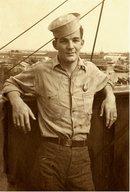
|

|
|
|
|
James was born at home in Mooringsport, Louisiana, to William Theodore Collier and Ruby Eddins Collier. He was the younger of two sons (his brother was William Eddins Collier), although two of his cousins, whose mother had died, also lived with them in their house on Caddo Lake. His father was a warehouse man for Gulf Oil Company. To supplement the family table, James raised vegetables that his mother canned, and sold turnip greens and black dewberries. While the family had little money they had plenty to eat, and often shared their fare with homeless men, then called "hobos," who drifted their way along the KCS Railroad. "I remember them coming always to the back door," he recalls. "Some of them would ask for work, you know, for something to eat." James graduated from Mooringsport High School in May of 1943 while still seventeen. He worked as a roughneck on an oil-drilling rig before enlisting in the U.S. Navy on August 31, 1943. After seven weeks of boot camp in San Diego, he was assigned to landing craft, and practiced landings in Higgins boats in San Diego and at Camp Pendleton. Sent to Pearl Harbor in December of 1943, he was assigned to a cargo ship, the USS Mercury (AK-42), and sailed in a convoy transporting the 22nd Marine Regiment and the 106th Infantry Regiment of the 27th Infantry Division (he believes) to Kwajalein, where those units served as floating reserves. From there the Mercury sailed to the Marshall Islands, where he saw combat for the first time at Eniwetok in February of 1944. Aboard an LCM, he made several trips between ship and shore, and was subject to machine gun fire from Japanese on land. "We were completely exposed," he says of being aboard an LCM. "We were standing up on the deck so far above the water and there wasn't any place to hide on one of them," he remembers. James transported men as well as many kinds of supplies--from shells for a 105 howitzer to a bulldozer blade. His craft also took wounded personnel out to a hospital ship. During one week he helped transport men and materials day and night, without ever getting back on the Mercury. "I've gone to sleep standing at the wheel. I'd wake up when I hit the beach," he says. One crewmember, Bobby Gene Drew, only 16 when he went overseas, was badly wounded but recovered. Another named Cumberworth (he doesn't remember his first name) was mortally wounded. In August of 1944 James was sent to Pearl Harbor where he was assigned to the USS President Hayes (APA-20) He was soon made third class gunner's mate and also served as a master of arms. In October of 1944, he participated in the Battle of Leyte Gulf. On November 10, 1944, his vessel was berthed near the USS Mount Hood (AE-11) at Manus Island near New Guinea when a massive explosion rocked that ship and caused great loss of life. The President Hayes returned to San Francisco for repairs in December of that year. With nine days of leave James traveled to Louisiana, spent two days at home, then rushed back to his ship to sail to New Caledonia. In the next several months, James says he sailed to New Guinea, Australia, Guadalcanal, and Manila. He was in San Pedro, California, when the war ended, and in severe pain from a kidney ailment. After surgery in a naval hospital, he returned to the President Hayes, remaining aboard until "around the first of March." He was discharged in New Orleans. In the fall of 1946 he entered Centenary College, finished two semesters, and underwent another kidney operation. On December 24, 1950, he married Mary Lee Koonce. They would have two children, three grandchildren, and one great-grandchild. After he graduated from Centenary in 1951 he worked for Universal Oil Products Company. In 1959 he became business manager at Broadmoor United Methodist Church, a position he held until his retirement in 1990. |


